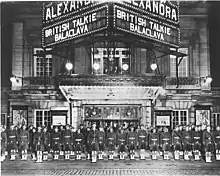| Balaclava | |
|---|---|
 Balaclava at the Royal Alexandra Theatre in Toronto, Canada, after its release as a talkie | |
| Directed by | Maurice Elvey Milton Rosmer |
| Written by | Boyd Cable Gareth Gundrey W. P. Lipscomb Angus MacPhail Milton Rosmer Robert Stevenson |
| Based on | "The Charge of the Light Brigade" by Alfred, Lord Tennyson |
| Produced by | Michael Balcon |
| Starring | Cyril McLaglen Benita Hume Alf Goddard Miles Mander |
| Cinematography | Percy Strong James Wilson |
| Edited by | Ian Dalrymple |
| Music by | Louis Levy |
Production company | |
| Distributed by | Woolf & Freedman Film Service |
Release date |
|
| Country | United Kingdom |
| Languages | Silent Version (1928) Sound Version (1930) (English Intertitles) |
Balaclava is a 1928 British silent and sound war film directed by Maurice Elvey and Milton Rosmer and starring Cyril McLaglen, Benita Hume, Alf Goddard, Harold Huth, and Wally Patch.[1] It was made by Gainsborough Pictures with David Lean working as a production assistant. The charge sequences were filmed on the Long Valley in Aldershot in Hampshire. Although the sound version had no audible dialogue, it featured a synchronized musical score with sound effects. The sound version was released in the United States under the title Jaws Of Hell.
Plot
A British army officer is cashiered, and re-enlists as a private to take part in the Crimean War. He succeeds in capturing a top Russian spy. The film climaxes with the Charge of the Light Brigade.[2]
Cast
- Cyril McLaglen as John Kennedy
- Benita Hume as Jean McDonald
- Alf Goddard as Nobby
- Miles Mander as Captain Gardner
- J. Fisher White as Lord Raglan
- Henry Mollison as Prisoner's Friend
- Betty Bolton as Natasha
- Robert Holmes as Father Nikolai
- Harold Huth as Captain Nolan, Adjutant
- Wally Patch as Trooper Strang
- H. St. Barbe West as Prosecutor
- Boris Ranevsky as Tsar
- Wallace Bosco as Lord Palmerston
- Marian Drada as Queen Victoria
Production
Portions of Balaclava were reshot under the direction of Milton Rosmer with dialogue written by Robert Stevenson and it was re-released as a sound film which featured a synchronized musical soundtrack with sound effects in April of 1930.[3][4]
References
External links